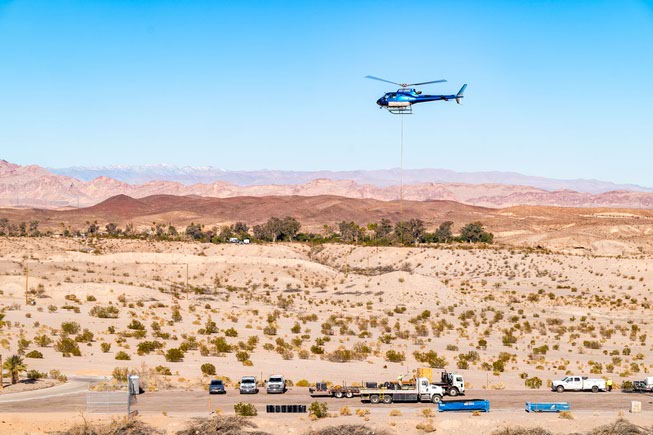
A helicopter transports some drill fly skids and a supply agritainer between the former Las Vegas Bay Marina and the site of a new weir the Southern Nevada Water Authority plans to build Wednesday, January 8, 2024. The platforms will be used to conduct geotechnical surveys of the banks’ soil.
Monday, Jan. 15, 2024 | 2 a.m.
Engineers are taking samples of the Las Vegas Wash’s sandy banks as they prepare for construction of a low dam to prevent erosion caused by water flowing to Lake Mead.
The data they gather will support design of a weir — a concrete, damlike structure to slow and calm the water’s flow through the wash.
Through early spring, Crux Subsurface Inc. will fly equipment to the wash by helicopter and drill into the ground to take soil samples.
Parsons Corporation, which is managing construction of the project, said the survey will determine the stability of the banks.
“That includes drilling down into the bedrock and then pulling out core samples so they can see any changes in the geology that is underground,” Southern Nevada Water Authority spokesman Bronson Mack said. “That informs them and helps them make sure their engineering is appropriate for the conditions.”
The wash is a 12-mile channel through the Las Vegas Valley that carries stormwater and other urban runoff to the lake. Two water reclamation facilities along the wash also discharge water into the wash.
Solid rock would make the best foundation for the weir. But below the surface, much of the wash is made up of large rocks, smaller stones and sand.
The weir will be 162 feet wide, 15 feet tall and about 150 feet long.
At high speeds, water scours the sides and bottom of the wash and carries the sediment into Lake Mead. Suspended material and phosphates in treated wastewater don’t have time to settle out or get absorbed by plants along the wash’s banks.
Water quality issues came to the Water Authority’s attention in the late 1990s, Mack said, and a plan was created to prevent the erosion from worsening.
The upper stretch of the wash has seen improvements under the plan over the last few decades.
The slower water velocity in that section of the wash helps the banks stay intact, allowing vegetation to take root and improving the wildlife habitat and water quality.
“It’s a night and day difference when you see what that looks like versus what you see down here,” Mack said, referring to the last four miles of the wash, where five weirs are planned.
Some $35 million in Bureau of Reclamation and National Park Service grants secured by the Water Authority will cover construction of the first weir. The rest of the estimated $61 million in construction is contingent on funding, Mack said.
[email protected] / 702-948-7836 / @Missmusetta
